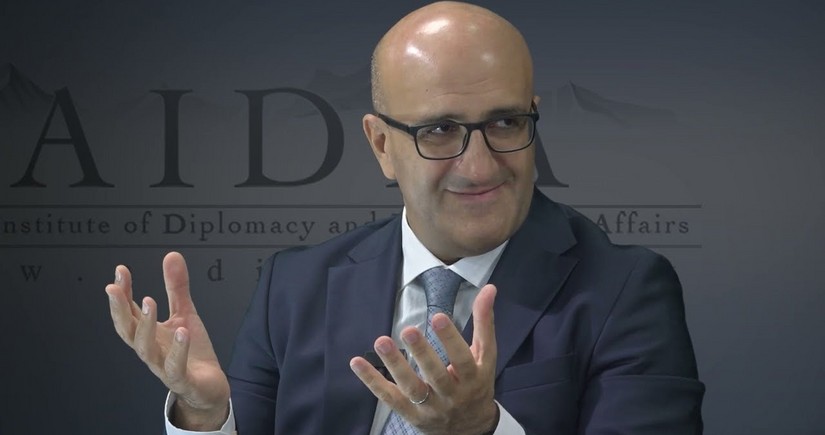Ambassador: Mines are main obstacle for return of displaced persons to Karabakh and Eastern Zangazur
- 05 June, 2025
- 18:35

An article by Elchin Huseynli, the Ambassador of Azerbaijan to India and non-resident Ambassador to Nepal, on the mine problem in Azerbaijan's liberated territories has been published by NepalKhabar.
Report presents the article:
On December 8, 2005, the United Nations General Assembly declared that April 4 of each year shall be observed as the International Day for Mine Awareness and Assistance in Mine Action.
It called for continued efforts by States, with the assistance of the United Nations and relevant organizations, to foster the establishment and development of national mine-action capacities in countries where mines and explosive remnants of war constitute a serious threat to the safety, health and lives of the civilian population, or an impediment to social and economic development at the national and local levels.
Today, the global problem of mines and unexploded ordnance (UXO) continues to cause significant harm, killing and injuring civilians, hindering development, and restricting access to livelihoods, with children being disproportionately affected.
Nearly 70 countries around the world have been contaminated with landmines and UXO, which pose a constant and grave threat to civilians, especially in conflict-affected areas. Thousands of people are killed or injured annually by landmines and UXO, with a significant percentage being children.
UXO contamination restricts economic opportunities, prevents agricultural development, and increases the cost of development projects. Buried UXO can also cause environmental contamination, such as the contamination of soil and groundwater by explosives and other chemicals.
According to the Landmine Monitor 2024, Myanmar surpassed Syria as the country with the highest number of landmine casualties in 2023, with 5,757 new victims recorded across 53 countries and two other areas, including 1,983 deaths. Civilians made up 84% of these casualties, and shockingly, children accounted for 37%.
The scale of the problem in Azerbaijan
According to Landmine Monitor, Azerbaijan remains one of the most heavily mine-contaminated countries, with an estimated 1.5 million landmines posing a threat to over 13% of its territory. Starting from 1991, during the occupation and aftermath of the Second Karabakh War in September-November 2020 and throughout the post-conflict period, Armenian military forces have extensively planted mines in the formerly occupied territories of Azerbaijan, both in the Karabakh region and seven adjacent districts.
Since the end of the war in November 2020, 397 Azerbaijani civilians have been killed or seriously injured, despite the country immediately launching extensive humanitarian demining operations. In total, over 3,400 Azerbaijanis have been victims of mines since the conflict began in 1991 – including 362 children and 38 women.
Despite the end of the Second Karabakh War, which is also named in Azerbaijan as “the 44-day Patriotic War” in November 2020, Armenia continued its deployment of landmines until its forces were eventually forced to leave Azerbaijani territories as a result of the local anti-terror measures in September 2023.
In 2022, it was revealed that more than 2,700 anti-personnel landmines, produced in Armenia in 2021, had been planted in the Lachin and Kalbajar regions of Azerbaijan. This revelation proved that Armenia’s long-standing claims of non-production and non-export of landmines were completely false. Furthermore, following the anti-terror measures in September 2023, more than 500,000 landmines were discovered in Azerbaijani territories, including those where the Russian peacekeeping forces had been deployed. This underscores the scale of the ongoing threat.
Demining efforts of the government and the international assistance
Given the devastating impact and magnitude of the landmines, Azerbaijan has prioritized humanitarian demining of Karabakh and East Zangazur regions. While international partners support Azerbaijan’s efforts, more assistance is needed. To date, more than 200 thousand hectares of land have been cleared by Azerbaijan National Agency for Mine Action (ANAMA) and other operators, more than 180 thousand explosive devices, including anti-personnel and anti-tank mines, and unexploded ordnances have been successfully detected and neutralized.
Landmine clearance is a complex and lengthy process, but Azerbaijan has mobilized its resources and invested in the latest technologies to enhance efficiency.
However, despite the significant efforts made, international support remains insufficient. While Azerbaijan’s government funds approximately 95% of the demining operations, given the scale of the problem, contributions from international organizations and partner countries (i.e. KSrelief, NSPA, MLI, Roots of Peace, ARMAC, and MAG) are not enough to meet the full scale of the challenge. More political and practical support from the international community is urgently needed to mitigate the humanitarian consequences of landmines and help clear the affected areas.
Mines as impediment to the return of IDPs and infrastructure reconstruction
Despite Azerbaijan’s repeated calls, both before the 44-day Patriotic War and during the post-conflict period, to provide landmine maps, Armenia for a long time denied the existence of such maps. After international pressure, Armenia provided some of them, but those covered only a small portion of the landmine-planted areas and were only 25% accurate. Over 55% of recent landmine cases have occurred outside the areas covered by these maps.
Moreover, while Armenia’s maps indicated that approximately 400,000 landmines were planted in Azerbaijan’s territories, the actual number is closer to 1.5 million. The soonest provision of the accurate maps of all landmine sites will create the necessary security conditions for the safe return of IDPs and the ongoing reconstruction effort of Azerbaijan in the affected regions.
Since 2022, over 10,000 former IDPs have returned to 10 settlements in the Karabakh and East Zangazur regions of Azerbaijan.
Approximately 30,000 people now live and work in these areas, contributing to sectors such as construction, government, and other industries. By the end of 2025, 30 settlements will accommodate former IDPs. The Azerbaijani government has taken significant measures to ensure the development of these areas, focusing on job creation, sustainable regional development, and providing decent living conditions. The government is constructing modern housing, building infrastructure, and providing essential amenities. Economic initiatives in small business development and agriculture are underway to boost the local economy. These efforts are all aimed at ensuring that people can return to Karabakh and East Zangazur in a safe, stable, and prosperous environment.
Additionally, both Karabakh and East Zangazur have been designated as green energy zones. Since the end of the 44-day Patriotic War in 2020, Azerbaijan has invested significantly in hydro energy, with 270 megawatts of hydroelectric power already operational within four years.
The current mine threat in Azerbaijan is a real security problem, and a significant obstacle to peace, reconciliation and sustainable development.
Azerbaijan’s global outreach activities
Azerbaijan has actively raised international awareness about the severe landmine problem in Karabakh and East Zangazur. In 2023, humanitarian demining was formally recognized as the 18th National Sustainable Development Goal in Azerbaijan. The country has been actively advocating to have it recognized as the 18th Global Sustainable Development Goal by the United Nations.
Additionally, Azerbaijan proposed the creation of a Special Contact Group on Humanitarian Demining within the Non-Aligned Movement, which became operational in September 2023. In 2023, Azerbaijan also led a resolution at the 15th meeting of the states-parties to the “1954 Hague Convention for the Protection of Cultural Property in the Event of Armed Conflict,” titled “The Impact of Mines on Cultural Heritage.”
In May 2024, a letter of intent was signed between the ANAMA and the UN Development Program on establishment of “Center of Excellence” to provide education on the mine action. This notable development will allow Azerbaijan to share its expertise with the countries that face similar problems. These efforts highlight Azerbaijan’s ongoing commitment to addressing the global landmine crisis and increasing awareness of the issue.
On April 4, 2025, the Permanent Mission of Azerbaijan in the UN and the Center of Analysis of International Relations (AIR Center), a Baku-based leading foreign and security policy think-tank, organized discussions on the topic of “Saving Lives Through Humanitarian Mine Action in Azerbaijan” at the UN Headquarters in New York. The event was dedicated to the International Day for Mine Awareness and Assistance in Mine Action, brought together key stakeholders in the field of mine action to discuss the humanitarian challenges posed by landmines and explosive remnants of war in Azerbaijan.
